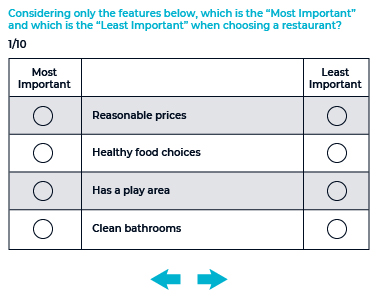Published on July 7, 2020 by Amit Mehndiratta
Maximum differential analysis and conjoint analysis (MaxDiff vs conjoint) are both advanced analytical tools used to obtain deep insights into customer preferences and differences between preferences score multiple brands/products. Below, we provide a quick comparison of both the techniques.
Difference between MaxDiff and conjoint analysis
MaxDiff analysis
This approach is used to obtain preference/importance scores for multiple items. Respondents are typically shown 2-6 items on a single screen (e.g., different types of vehicles – midsize truck, sedan, minivan, SUV, mini SUV, hatchback, sports car, convertible, etc.) and asked to identify the best and the worst items. The method is also known as the best-worst scaling-type tool. This task is repeated multiple times, with a predefined set of combinations shown each time. The most popular common applications where this technique can be employed include message testing, brand preference, customer satisfaction and product features. Finally, data are compiled together, and the output is generated as utility scores for each item. The analysis of MaxDiff utility scores usually contains data that demonstrate how many times each attribute was displayed and the number of times each attribute was chosen as the best and the worst attribute. These three parameters relatively determine the importance of each item, providing clues to big brands on features that need to be embedded while manufacturing their products.
Conjoint analysis
In conjoint analysis, more parameters are added to the experiment, and a product/service is described by multiple attributes. Therefore, in the above example of cars, the brand and price attributes, in addition to vehicle type, would be added in a test. Product features are varied to make different combinations such as packages, a.k.a. product concepts. Respondents are then asked to rate/rank or, most commonly, choose (depending on the type of conjoint analysis) the concept they prefer (dependent variable). Based on the results drawn from respondents’ opinions about the concepts, one can ascertain how valuable each feature – airbags, power windows, infotainment system and antilock brakes, among others – in the product is.
The key difference between the conjoint and the MaxDiff analysis is in conjoint analysis, the rating/choice of a concept is based on the sum total of its components. As stated above, it assumes an additive model, where the value of an overall product concept is equal to the sum of its parts. On the other hand, the MaxDiff method is not an additive model. It is an individual item/attribute-score-based technique.
|
MaxDiff Analysis |
Conjoint Analysis |
|
|---|---|---|
|
|
|
|
What they do |
|
|
How they work |
|
|
Similarities |
|
|
Differences |
|
|
How can we help?
Acuity can help the client with end-to-end services like suggesting the clients with the best analysis technique that they can use for their products and make it better with the results. Maxdiff and conjoint exercises can be incorporated with/without other questions in a survey to generate the best and effective results.
Sources
Table Source - www.sawtoothsoftware.com
Tags:
What's your view?
About the Author
Amit Mehndiratta is the Delivery Lead in Survey Programming practice with overall experience of 10 years. He has been a part of this organization for last 2.5 years now. He has worked in various domains of market research like Quality Assurance, Client services, Project management, Research and development etc. Amit has previously worked with Toluna India Pvt Ltd and Knowledge Excel Services
Comments
20-Aug-2021 12:17:12 pm
Well explained article.
Like the way we think?
Next time we post something new, we'll send it to your inbox









